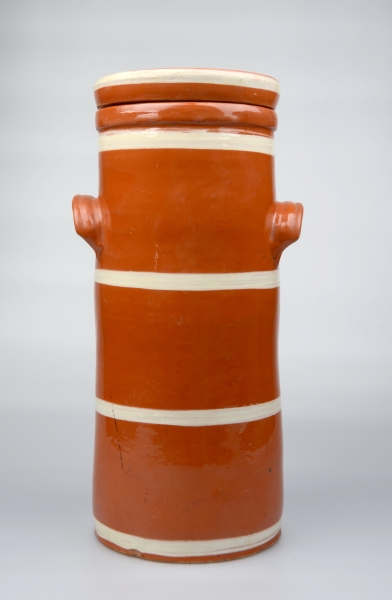
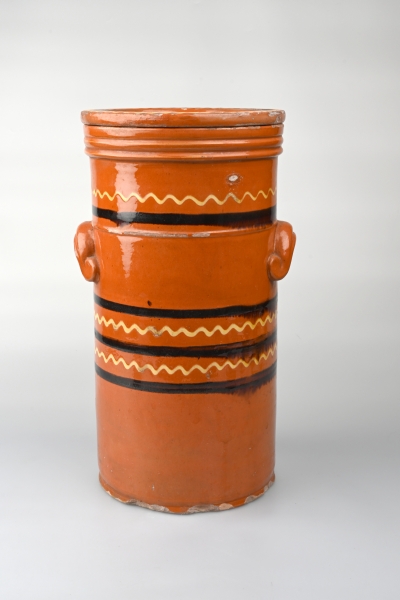
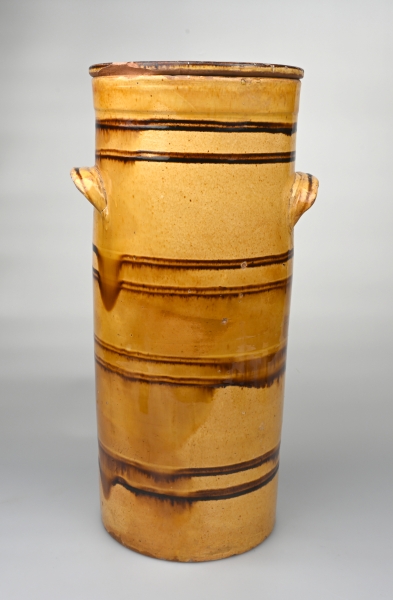
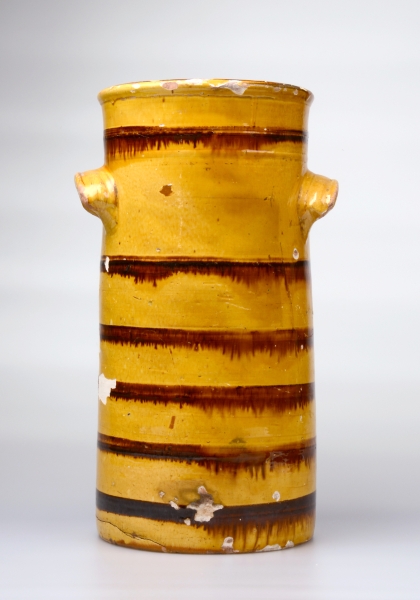
Horizontal bands in CERAMICA CH
Andreas Heege, 2022
One of the groups of earthenware vessels that were highly characteristic of the period between 1850 and 1900 in the German-speaking areas of Switzerland were decorated with bands of white, black, blue or black and white horizontal stripes or bands which were probably painted on using a brush.
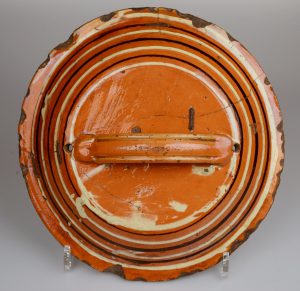

The pattern can be found on numerous types of vessels: cups and saucers, milk jugs, small tureens or bowls with horizontal handles, deep dishes with bevelled rims, butter churns, flowerpots and bowl-shaped lids. They all bear a coating of white, beige (buff) or red slip. This type of decoration was widely used in the German-speaking parts of Switzerland at that time (a current list with references for further reading can be found in Heege 2021, 130-131). In 1870, a Heimberg tureen with horizontal bands was even put on display in an industrial exhibition in London (Victoria & Albert-Museum, London Inv. C.612&A-1921). In 1894, Berneck potters were decorating milk jugs with this type of pattern (Heege 2016, Fig. 15). The Index of goods from the Scheller pottery manufactory in Kilchberg-Schooren ZH published shortly before 1859 includes “milk jugs, barrel-shaped” with similar decorations (Ducret 2007, 28). A sales catalogue of the Schramberg manufactory of refined white earthenware (post 1855) also includes comparable earthenware vessels (Staffhorst 2020, no. 273, “milk jug, slipware”), which is not surprising given the close ties between the pottery-producing factories in the mid-19th century. These wares were probably inspired by refined white earthenware vessels with horizontal bands, so-called “annular” or “banded wares” that were being imported from England in ever-greater numbers from the early 19th century onwards (Hume 1969, 131; Majewski/O´Brien 1987, 160–161). We can therefore assume that this popular type of decoration was probably produced in various places throughout the German-speaking parts of Switzerland in the second half of the 19th century. Examples dating from prior to 1850 have not yet come to light. It is unclear, to date, how far into the 20th century the pattern continued to be used (1920/1930?).
Translation Sandy Haemmerle
French: décor à bandes horizontales
German: Horizontalstreifendekor
Bibliographie:
Ducret 2007
Peter Ducret, Bedrucktes Steingut aus der Manufaktur Scheller in Kilchberg, in: Keramik-Freunde der Schweiz, Mitteilungsblatt Nr. 119/120, 2007.
Heege 2016
Andreas Heege, Die Ausgrabungen auf dem Kirchhügel von Bendern, Gemeinde Gamprin, Fürstentum Liechtenstein. Bd. 2: Geschirrkeramik 12. bis 20. Jahrhundert, Vaduz 2016.
Heege 2021
Andreas Heege, Neuzeitliche Keramik aus der Chesa Giorgio, S-chanf, Cinuos-chel, in: Archäologie Graubünden 4, 2021, 117-177.
Hume 1969
Ivor Noël Hume, A guide to artifacts of Colonial America, Philadelphia 1969.
Majewski/O´Brien 1987
Teresita Majewski/Michael O´Brien, The use and misuse of nineteenth-century english and american ceramics in archaeological analysis, in: Michael B. Schiffer, Advances in Archaeological Method and Theory, Bd. 11, 1987, 97-209.
Staffhorst 2020
Andreas Staffhorst, Schramberger Steingut 1820-1882 (Schriftenreihe des Stadtarchivs und Stadtmuseums Schramberg 30), Schramberg 2020.

